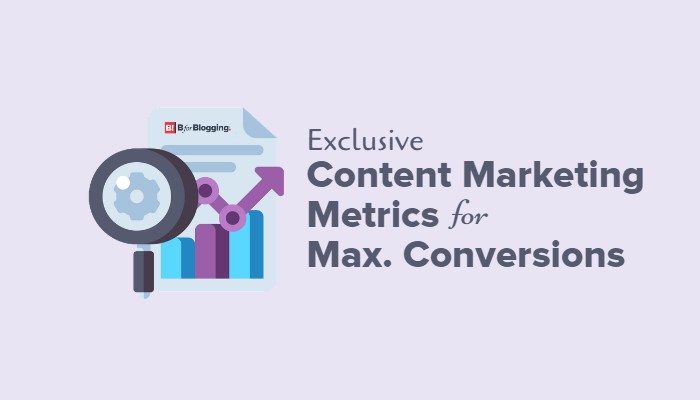The value of content marketing continues to rise for lots of brands, but have you ever imagined that which metrics do you use to track your maximum conversions?
Here, in this post, I have outlined 13 content marketing metrics that will help you on what you should concentrate on to understand the ROI of your campaign.
As more and more brands and businesses turn to content marketing, there is even a growing pressure to showcase results.
Giving readers some valuable, engaging content is incredible, but businesses also require measuring the effect of those contents to determine the best type of content on their blog or site, best distribution channels, most efficient advertising approaches, and social media strategies.
We all know that without measuring the performance of our content, it’s hard to say that whether the marketing efforts are actually working or not. So this is why you should measure the success of content marketing.
There are a few metrics that can help you track the conversions as well as long-term ROI of your content
To help you map the outcomes of your content marketing approach, I have put together 13 CORE content marketing metrics to track conversion and long-term ROI.
Here we are going to discuss what metrics you will need to track at what kind of stage of a marketing campaign.
The Metrics Framework
The very first thing that I want to let you know is that each and every content marketing metrics are not equally helpful in each stage of the content lifecycle.
Different content marketing metrics are useful at various stages. Thus, to break down every single campaign into individual phases and track different metrics for individual phases. Here I have listed three various stages:
- Traffic Generation
- Engagement
- Conversion
This is just the overview, I am going to break down each of the phases in detail.
13 Content Marketing Metrics for Maximum Conversions
Stage #1 – Traffic Generation
Begin with one of the most crucial stages that is traffic on your site, how many people does your content attract?
To find this and a few more things it is essential to test distinct content marketing metrics to locate the success of your content.
For that investing time behind this is more important, because this is what makes you create valuable content for your targeted audience.
Make sure you use these metrics after every three months because this phase usually lasts for three months, or until you had developed a library of content and attracted a decent amount of traffic to your site.
So, here are some of the essential metrics that you should look at:
#1. Total Unique Visitors
The very first metric here is how many unique visitors are visiting your site.
This might sound very basic to you, but such primary metrics will tell you whether your marketing efforts are working or not.
The higher the number of visitors you have on your site the better you are able to see your content success.
#2. Total Page Views
This metric helps you find how many total pages your audience plus unique visitors visit on your site. This is an important metric but if you are a media company then this can be misleading.
Like site design, traffic source, and plus your industry will have a huge impact on page views.
So I recommend you to focus on unique visitors, rather than making a big decision depending on this metrics number.
#3. Total Backlinks
For each, every marketer in content marketing, all of them wish to have good SEO for their site. And when it comes to having good SEO backlinks plays a huge role.
If you need good SEO, you need to track the number of sites linking to your site. This will help you measure your content distribution efforts. The higher the number of linking sites, the better your rankings in search engines.
#4. What is the Source of Traffic?
Find what the source that your users are coming to your site is?
Is it just search or are they coming from social media platforms or any other referral source?
Then try to identify what works best for your content marketing strategy. Once you have found your tops source, promote your content appropriately.
Grab Ideas to Boost Traffic
- Proven Strategies to Increase Blog Traffic Instantly
- How to Generate Traffic from Flipboard to Your Blog
Know Ways of Building BackLinks
- Find Quality and Unlimited Content Along with Quality Backlinks
- 15 Secret Ways to Get Quality Backlinks Naturally to Your Blog or Website
Don’t Get Confused with SEO
Stage #2 – Engagement
The success of your content can’t be calculated only by the people who have visited your site. The actual success of your content marketing strategy is indeed measured based on engagement.
This is now time to engage with your loyal audience and also the unique visitors and turn them into readers, not just only visitors.
Into you content marketing campaign; this stage lasts for three to six months. So follow these engagement metrics:
#5. How Many Bounce Rate?
Bounce rate is another metrics that help you define the percentage of visitors who move away from your website after observing only one page.
If the percentage of bounce rate is going down, then this means your readers are engaging more with your site content.
And if the percentage is higher of bounce rate, then this means your readers are not engaging with your site’s content.
This is actually a slow process of analyzing and distributing the content that is right for more engagement. I have seen many people ask what amount of bounce rate is acceptable!
There is no accurate answer for this because there is the rate varies by content type and the industry of course.
However, if the bounce rate is in the range between 26%-40%, then this is incredible for content-focused sites, while if it is between 41%-55%, then it is roughly average.
#6. How Many New Visitors Compared to The Returning Visitors?
Generally, this is a self-explanatory metric that shows how many people are coming back to the site as compared to the new visitors.
If many people come back to your site and the rate of it is higher, then it indicates that the content is engaging and useful.
#7. Time Spent on Site
These metrics track that, how much time do users are spending on your site?
If the spending time is high, it means that they like your content.
You could also dig deeper and see on what page they are spending most of the time.
If you found that one page on which they are spending most of the time, then this would be great to generate more such content and put that on your site.
Observe what kind of content your readers or users are sharing on another platform from your site. This could be gifs, infographics, images, short posts, or long posts.
Note that people are willing to share content only which they like.
So if you want to make lots of shares of your content then make sure you provide valuable and useful content. And also keeping track of what kind of content makes more shares will help you create more such content.
#9. How Many Numbers of Comments?
As compared to social shares and likes of your content, comments on your content play a huge role.
People likely comment on articles only if they have been through the whole article considerably and find it useful for themselves.
Make sure how many numbers of incoming comments are the people leaving on the contents of your site.
Keep track of and engage with those individuals who leave comments on the content, and ask them to share their stories and ideas.
Based on this you can even open up a public discussion. This will help you build community.
Let Start Increasing Audience Engagement
- The Ultimate Social Media Checklist For Bloggers
- 10 Leading Social Media Influencers to Follow on Twitter
Stage #3 – Conversions
After this, the last stage comes, which is essential because this is what measures the efficiency of your content that turns your readers into leads. So let’s see those metrics one by one:
#10. How Many Opt-In Rates?
Here the meaning of opt-in is related to the opt-in (subscriber) form. Find out how many people fill out the subscriber’s form and become your subscriber.
This will show you that people who subscribe to your site want to read more content from you.
Those subscribers are the substantial lead for you, and in the future, you can turn into your paying or potential customer.
Thus, observe the opt-in rate and find out the opt-in forms/ pages, etc. through that subscribers are coming from.
If you are generating most of the traffic and also have high engagement with your readers, then the opt-in rates could be 30% or close to it.
To find this, you need to compare the ratio of engaged readers and opt-in users.
#11. CTA Click-Through Rates
If you have built top-of-the-funnel content like a blog article, then you will wish your potential leads to move down to the conversion funnel.
So to guide them toward this step you should give them a relevant CTA (call to action) for the next move or step. Here, CTA means hyperlink that you provide to your user, which you want them to click on.
If you have written content on tips and tricks on optimizing your blog traffic, then you should also connect other articles related to that content.
Connecting content to other content means you are attracting people to your site with content designed to turn them into leads is essential.
Your click-through rate will indicate whether you are connecting the right content and building a logical content funnel.
#12. How Many Numbers of Leads?
Once you have successfully guided your readers towards the connected content, then it is important that you measure how many readers actually go through.
This can indicate some things like how well the page of your site is designed, how compelling your copy is, or whether images in your content are useful and helpful to them, whether the opt-in is too tricky, etc.
Getting leads is not enough. Also, you need to measure the quality of them. And you need to get rid of those leads from bots.
#13. ROI
One of the most important and hardest to measure metrics is ROI. It is very easy to understand.
It is the measurement of the comparison of overall generated revenue through content marketing and investment in content building and distribution.
For that, the two things are necessary like the LTV of each consumer and a way to track your consumer’s journey.
If you are a CRM organization, then it is easy to track your customer journey. It will help you discover what content helped you make the final sale.
On the other hand, understanding your customer lifetime value will also help you determine the actual returns from every sale.
Tricks those help to Increase Conversions
- 50+ Powerful Tools To Grow Your Email List
- 3 Key Aspects To Measure Content Marketing Efforts
- 10 Best Google Search Engine Alternative List
Conclusion
There are certain marketing metrics that you could be tracking. But these exclusive metrics are crucial to your content marketing analysis.
They will help you estimate which content performs best, and on which channel, and how you can optimize its conversion rates.
Eventually, each piece of content that you produce should have an objective. So utilize these metrics to track and measure those goals.
Do let us know if you have any questions or queries, I would be happy to respond.




